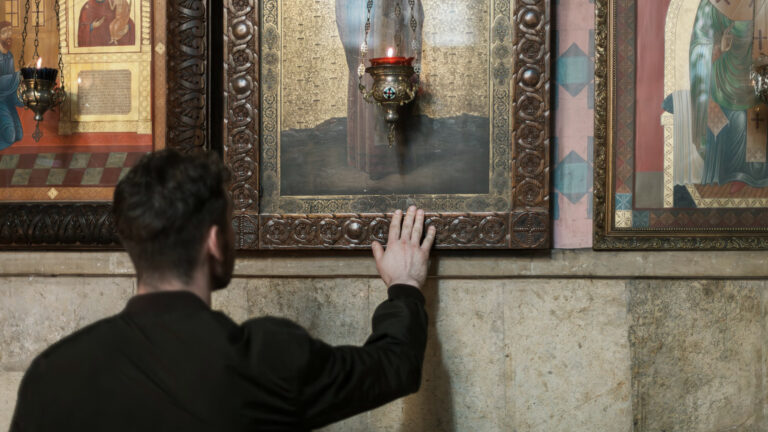The past five years have been challenging for the box office. The pandemic turned theaters into ghost towns. More and more people stream movies online nowadays. Production delays, and now a writers’ strike—all this has slowed the output from Hollywood.
Moviemakers have done their best to beckon us back to the theater, lifting up the big screen as a place to set aside distractions, gather with friends and family, and immerse ourselves in the stories being told.
Nicole Kidman and AMC
The cinematic promise is epitomized in AMC Theatres’ one-minute spot featuring Nicole Kidman. It begins as she strolls through a rainy night to the theater, gently lifting her hood as if she were a Jedi. Meanwhile, her voice describes the “magic” of the cinema, where we learn to laugh, to cry, and to care. As she ascends the stairs, she celebrates the “indescribable feeling as the lights dim” and we get the chance to go to another world. Kidman is the high priestess of this spiritual experience. We’re not there “just to be entertained,” she says, but to be “somehow reborn, together.”
The AMC ad was an unexpected hit, its rhapsodic script inspiring a parody on Saturday Night Live that expanded Kidman into a superhero and surrounded her with moviegoers who salute the screen as new adherents to this quasi religion. The ad elicited numerous memes and good-natured ribbing, especially for the unintentional campiness of the line “Heartbreak feels good in a place like this.”
Deeper Longing
Every effective marketing campaign taps into deeper longings than the surface-level issues it addresses. It’s a running joke every year when Super Bowl commercials wow us with attention-grabbing humor or inspiring stories that often have little to no connection with the brand being represented. (A longer Christmas ad for Chevy last year, a tearjerker if ever there was one, emphasizes the nostalgic power of the brand while implying a Chevy truck can reverse dementia.)
It’s no surprise, then, that AMC wants to portray itself as more than a place where you can see a good movie at a decent price with comfortable seats; the theater offers an experience that fulfills a more profound need. Something deeper than mere entertainment. Rebirth is the goal. The cinema becomes a portal through which we escape the confines of our ordinary lives. This is where we experience the full range of emotions (laughing, crying)—a place “we all need,” Kidman says, if we’re to make progress in personal growth and fulfillment. (It’s where we learn “to care,” she tells us.)
All this is spiritual language. When the lights dim, spiritual illumination begins. All this is tapping into the deepest longings of humanity—for connection, for growth, for inspiration, and for stories that bring resolution.
Promise That Can’t Be Kept
Here’s what stands out most to me about this ad. Despite Kidman’s repeated use of plural pronouns and her emphasis on being reborn together, she’s alone in the theater. The emptiness of the cinema strikes me—no one in the parking lot, hallway, or the theater itself. The only others present are the stars on the screen. Here we have the paradox of a supposedly shared experience in a cavernous room where the moviegoer is all alone. Right there, we can see why the cinema can’t deliver on its promise. Entertainment today is more likely to isolate us than bring us together.
We’re the most entertained generation in human history. Entertainment is so prevalent and prominent that it takes a conscious choice to avoid it. The number of choices available on various platforms can lead to decision paralysis and a sense of loneliness. It’s not uncommon for people to watch a television show at 1.5 or 2x speed, increasing their capacity to digest even more entertainment. “Bingeing” isn’t a word that refers to healthy habits in any context, and yet now we use it to describe the practice of stuffing ourselves with television and movies.
We’re more entertained than ever, but this hasn’t increased our happiness. We’re not better off. The screen tends to isolate us, to draw us up into ourselves rather than turn us outward in love for God and neighbor.
Does the Church Do Better?
How wonderful if we could provide a striking contrast between the unkept promise of the cinema and the church as a refuge of true spiritual renewal and rebirth, where we experience fellowship with God and with others. But all too often the values of Hollywood are on display in our churches also. Our production may be excellent, our sermons memorable, our musicians professional, but what happens when, like in our trips to the theater, we gather with other individuals, experience “the show,” and then depart as lonely as before?
The inability of entertainment to deliver on its promises gives us the opportunity to do something different, to live and worship in a way that resolves the paradox of the AMC ad. The high priestess of Hollywood assures us we can be reborn together, but there she sits—alone in a cold, dark theater. Meanwhile, the church lifts up the Great High Priest who made it possible for us to be truly reborn—born from above into a new family, given a truly perfect and powerful story that far exceeds anything on offer in movies, and welcomed to his table where we draw close to him and each other.
Worship should feel less like spectators in a theater and more like a gathering around the fireplace, where in song and story, we warm our hands at the hearth, learn to see and to be seen, as companions who savor spiritual food for the journey and lock arms in mission to the world around us.
If you would like my future articles sent to your email, as well as a curated list of books, podcasts, and helpful links I find online, enter your address.

















